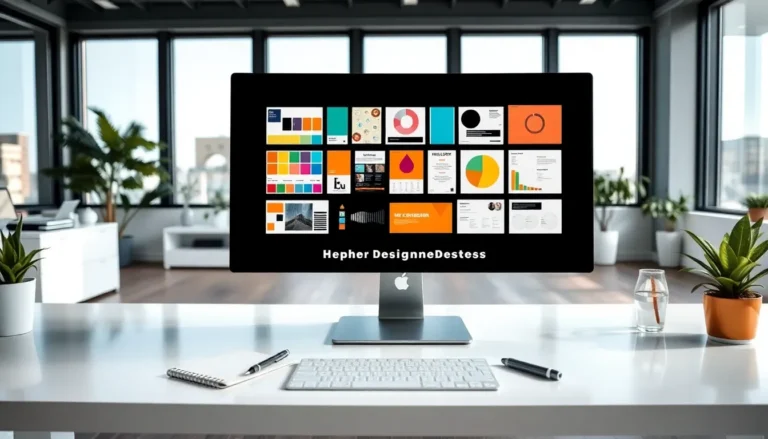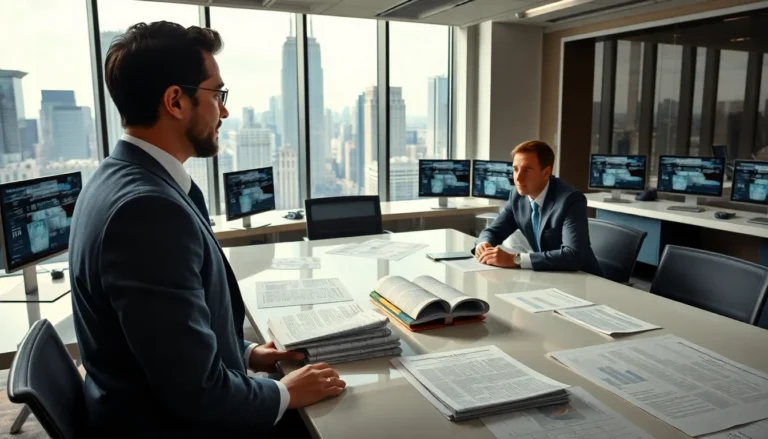Table of Contents
ToggleIn the bustling world of dining, the ambiance often speaks louder than the menu. Restaurant design concepts aren’t just about aesthetics; they’re the secret sauce that can elevate a meal from ordinary to unforgettable. Imagine stepping into a space that feels like a warm hug or a thrilling adventure—this is the power of thoughtful design.
From cozy nooks perfect for date nights to vibrant layouts that spark conversations, the right design can turn a simple meal into a memorable experience. It’s not just about where you eat; it’s about how you feel while you’re there. So, buckle up as we explore the art and science behind restaurant design concepts that not only attract diners but keep them coming back for more. After all, who wouldn’t want to dine in a place that feels like a masterpiece?
Overview of Restaurant Design Concepts
Restaurant design concepts play a crucial role in creating memorable dining experiences. Thoughtful design enhances ambiance and encourages patron connections.
Importance of Design in the Dining Experience
Design impacts the overall atmosphere, influencing customers’ perceptions. A welcoming layout can improve comfort and encourage longer stays. Visual elements like color schemes and furniture arrangements set the mood and can affect diners’ emotions. Sounds, scents, and lighting also contribute to the overall experience. Customers often associate positive experiences with well-designed spaces, leading to repeat visits. Establishments that prioritize design attract attention and stand out in competitive markets.
Trends in Restaurant Design
Current trends reflect a focus on sustainability and innovation. Many restaurants incorporate eco-friendly materials and designs to appeal to environmentally conscious consumers. Open kitchen concepts foster transparency and engage diners in the cooking process. Additionally, technology integration, such as mobile ordering and digital menus, has become integral. Flexible spaces that adapt to various dining needs promote inclusivity and encourage social interaction. Many establishments also feature unique themes or local art to create distinct identities and enhance customer loyalty.
Key Elements of Restaurant Design
Restaurant design encompasses various elements that shape the overall dining experience. Attention to detail in specific areas enhances customer satisfaction and retention.
Layout and Space Planning
Effective layout and space planning optimize the flow of patrons and staff, ensuring a seamless dining experience. Tables and chairs are arranged to foster conversation while maintaining privacy. Balancing open spaces with cozy nooks creates an inviting atmosphere. Adequate pathways must exist for easy movement and access to service areas. Incorporating flexible seating accommodates different group sizes, making the space more versatile. Preferences for outdoor seating also factor into planning, allowing diners to enjoy fresh air when desired.
Color Schemes and Lighting
Color schemes significantly influence a restaurant’s ambiance and mood. Warm hues promote coziness and intimacy, while cooler tones evoke calm and serenity. Additionally, lighting plays a crucial role, setting the tone for the dining experience. Dimmed lights often create a relaxed setting, making evenings feel special. Bright lighting energizes the atmosphere, ideal for fast-casual restaurants. A combination of natural and artificial lighting enhances visibility while highlighting design features. Using strategically placed fixtures can also create focal points, contributing to an eye-catching interior.
Types of Restaurant Design Concepts
Various restaurant design concepts exist, each contributing to unique dining experiences. Choosing the right concept enhances customer engagement.
Traditional vs. Modern Designs
Traditional designs focus on classic aesthetics. Elements such as rich wood tones, muted colors, and intricate decor often create a familiar atmosphere. Many established restaurants utilize these design principles to evoke nostalgia and comfort. Modern designs, on the other hand, emphasize clean lines and minimalistic concepts. They typically feature bright colors, open spaces, and contemporary furniture, appealing to a younger demographic. Integrating technology into modern designs supports efficiency and engagement. Both approaches can successfully attract patrons, depending on the target market’s preferences.
Themed Restaurants and Unique Concepts
Themed restaurants offer distinctive experiences that go beyond food. Concepts can range from cultural themes to pop culture references, allowing patrons to immerse themselves in different worlds. Unique aspects, such as decor, menu items, and staff uniforms, create cohesive narratives. Restaurants focusing on local culture often incorporate locally sourced ingredients and art into their designs. Engaging customers through interactive experiences can also foster loyalty. Unique design concepts distinguish establishments in competitive markets, making memorable impressions that encourage repeat visits.
Case Studies of Successful Restaurant Designs
Examining successful restaurant designs showcases effective concepts that capture customer interest. These case studies illustrate the power of thoughtful architecture and decor.
Iconic Restaurant Examples
One notable example is Le Bernardin in New York City, which features sleek lines and a calming color palette. This space emphasizes elegance while prioritizing comfort. Noma in Copenhagen embraces natural materials and greenery, creating a connection to the surrounding environment. It enhances the dining experience through visual appeal and organic elements. The Cheesecake Factory utilizes eclectic decor and a diverse menu, attracting a broad clientele with its inviting ambiance and vibrant atmosphere.
Lessons Learned from Successful Designs
Successful restaurant designs demonstrate the value of detailed planning. Prioritizing layout enhances customer flow and staff efficiency. Incorporating flexible seating accommodates various group sizes, maximizing space utility. Lighting choices significantly affect atmosphere; ambient lighting fosters relaxation while brighter options energize. Color palettes also impart emotional responses, impacting diners’ perceptions. Integrating local art can create a profound connection to the community, increasing customer loyalty. These lessons highlight how design choices shape memorable dining experiences.
Future Directions in Restaurant Design
Restaurant design is evolving rapidly, influenced by sustainability and technology. Both areas play a crucial role in shaping the future dining experience.
Sustainable Practices in Design
Sustainable practices in design focus on reducing environmental impact. Many restaurants prioritize eco-friendly materials like bamboo and reclaimed wood for furniture. Energy-efficient appliances minimize electricity consumption while retaining quality service. Additionally, incorporating natural light reduces the need for artificial lighting during the day, enhancing ambiance. Water-saving fixtures further support eco-conscious operations. Some establishments even design vertical gardens inside their spaces, providing fresh herbs and a touch of greenery. These practices not only appeal to environmentally aware diners but also promote a sense of responsibility within the community.
Technology’s Role in Restaurant Design
Technology integration significantly enhances restaurant design and operational efficiency. Smart kitchen technologies streamline food preparation, ensuring consistent quality. Digital menus and ordering systems reduce wait times and improve customer interactions. Tablet ordering at tables enhances the dining experience, allowing for quick adjustments and personalized selections. Moreover, implementing camera systems and sensors can optimize staff scheduling and inventory management. These advancements not only create a more cohesive atmosphere but also attract tech-savvy consumers who appreciate convenience along with quality service. Keeping pace with technological trends improves restaurant functionality while enriching customer experiences.
Restaurant design is a vital component of the overall dining experience. By focusing on ambiance and thoughtful layout, establishments can create inviting spaces that resonate with customers. The right combination of color schemes, lighting, and furniture can significantly enhance comfort and encourage repeat visits.
As trends evolve, integrating sustainability and technology into design concepts will be essential for attracting modern diners. Emphasizing unique themes and local art allows restaurants to build distinct identities that foster loyalty.
Ultimately, a well-designed restaurant not only captivates patrons but also sets the stage for memorable experiences that keep them coming back.







